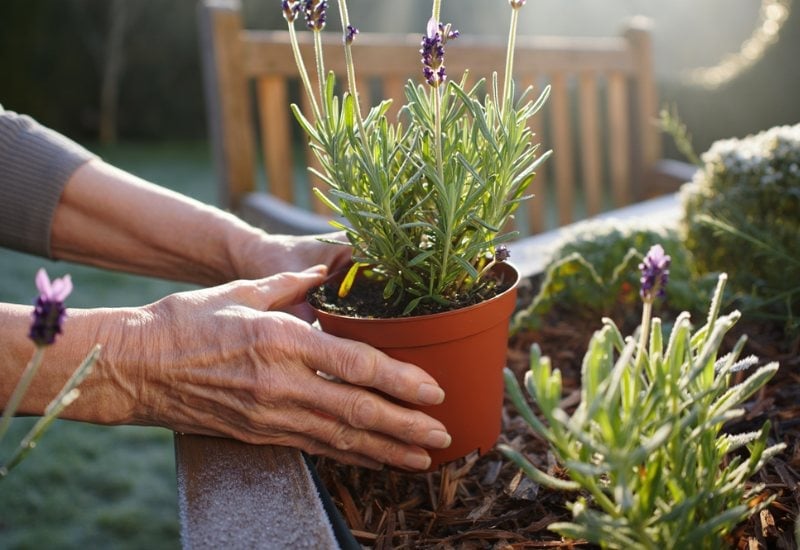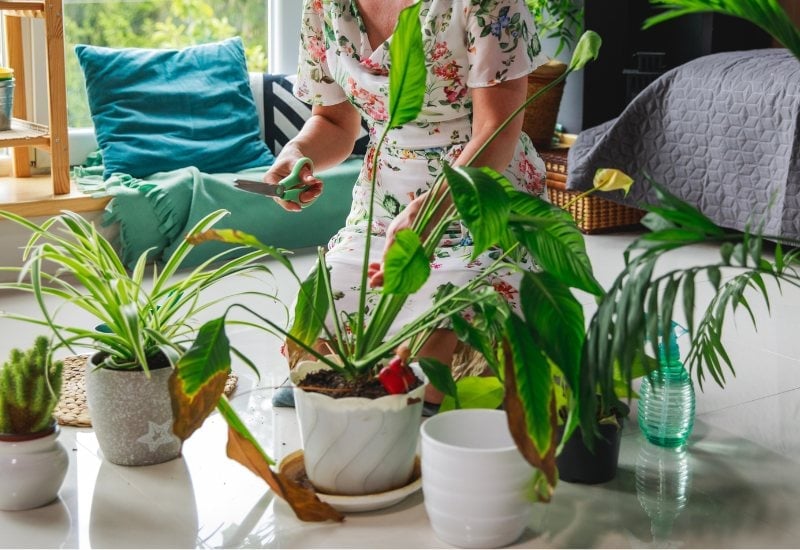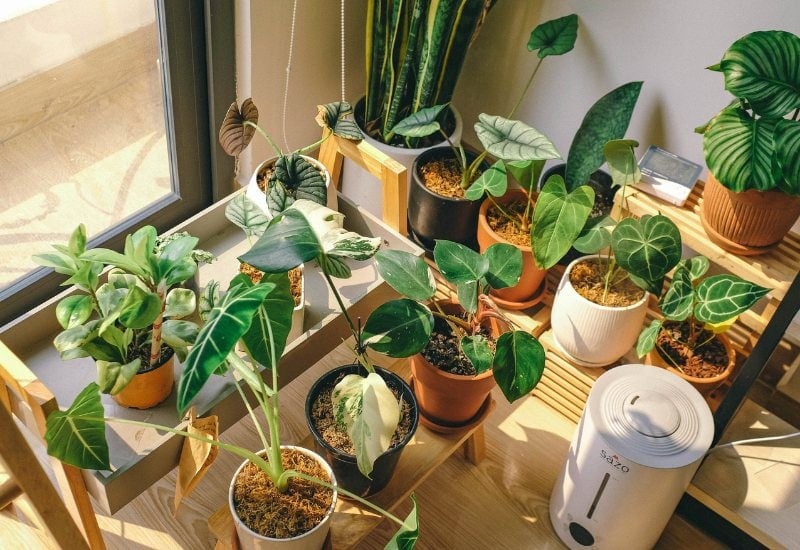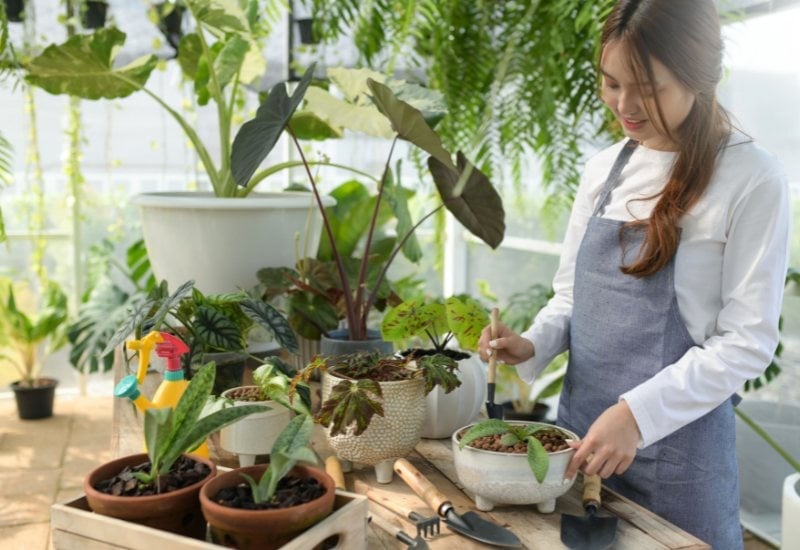
With fall coming to an end, it is time to bring your potted plants from outdoors to indoors for winter. Easy, isn’t it? You can just take them in and relax – and watch them suffer, or even die… Not all of them, and not always, but, especially your delicate perennials and little shrubs need a bit more care, some attention, and a bit of expert know how to find their new enclosed space hospitable enough to stay healthy…
In fact, moving your outdoor plants to an indoor space can cause them stress, and even a shock in severe cases, and thus can cause them to weaken, even to become sick, unless you do it professionally.
But what should you look out for, and what can you do to make this outdoor-indoor move less stressful for your potted plants? Let’s see, looking at each factor in turn…
Which Potted Plants You Should Take Indoors For Winter?

Which exact varieties you should take indoors to shelter them from the harsh winter weather depends on two factors:
- Your USDA hardiness zone.
- The hardiness of the potted plants.
Naturally, you should take indoors tropical and subtropical plants,including succulents, begonias, geraniums etc., but in colder climates, your list will grow to hardier varieties.
So, for example, if you have Spanish lavender (Lavandula stoechas) in containers, and you live in USDA zones 7 or below, you should take it indoors, because it is hardy to USDA zone 7, and it will survive in your garden but less likely in pots.
I’ll give you a general rule then. If your plant is hardy to at least 1 hardiness (better 2) zone below yours, you can leave it in your garden, otherwise, it can stay outdoors. This is because pots allow cold to reach the roots far more and faster than when they are in the ground of your land.
When To Take Potted Plants Indoors

To know exactly when to take your potted plants indoors, keep an eye on the weather forecast, and, especially to temperatures.
Again, it will depend on how hardy your plant varieties are, but I find it easier to do it all in one go, or in two groups maximum. But as a general rule, start moving your plants when daily temperatures fall to about 50o to 40oF (or 10o to 5oC) at night. This will give you plenty of time to acclimatize them in to their new place. Act faster in colder climates, because days get colder and colder very quickly! In warmer regions, you can take it more slowly.
However, if you are late, the bottom line is to take your potted pants indoors before temperatures reach a minimum of 32oF (or 0oC). All plants will survive temperatures above freezing.
Alternatively, for deciduous perennials and shrubs, you can use a different rule. Bring them inside as soon as they go dormant. When they shed their leaves, they are no longer useful to your garden, and they are “going to sleep” for the winter season.
And now, let’s go step by step through the process…
Prune Your Potted Plants, When Necessary, Before Taking Them Indoors

Of course, first of all you need to prune those potted shrubs and perennials that need it in fall, or by wintertime. This makes things easier and less messy, of course, but it also saves you indoor space, and it also helps them focus their energy on less “body mass”, and have a quiet and healthy dormancy…
If you do not know which perennials you should and shouldn’t prune in fall to overwinter them, we have guidelines for you in an article.
But there is another reason why you should prune potted plants before you bring them indoors for winter…
Check Your Pests And Diseases On Your Potted Plants Before You Bring Them Indoors For Winter

Once you have pruned your potted plants, it is easier to check for pests and diseases, and you should be doing it now for two reasons:
- You don’t want pests indoors (the “selfish reason”)
- These pests and diseases may and will probably worsen and spread indoors, to the same potted plant or others! Enclosed and poorly ventilated spaces are their ideal breeding ground, and even warm temperatures help them along.
But even if your potted plants are healthy, give them a good spraying with neem oil (1 teaspoon in a 1 liter bottle of water), which will prevent both infections and many bugs, and kill any spores of fungi and mold they may have but you cannot see yet!
I also have another tip for you to keep pests away from your potted plants when you take them indoors: stick some cloves into the soil! Yes, because they hate it, and some of them lay eggs underground…
And now they are “well groomed and healthy”’it is time to take your potted plants indoors, but…
Bring Your Potted Plant Indoors, But With The Right Light Levels!

When you bring your potted plants indoors to overwinter them, the light levels of their new place can be significantly different from those they had outdoors, in your garden or on your terrace. And drastic and sudden changes of light level can cause stress to all plants.
And so, the indoor space you choose should have a similar light level as outdoors…
But I have a little tip for you: if the indoor space is a bit dimmer, it is fine. Not very dark of course, but keep in mimd that days are getting shorter and your potted plant is going into dormancy…
And of course, the main risk and most common mistake is to bring your potted plant into a very well-lit room. Like a kitchen or living room where you have your lights on most of the day, especially in winter!
On the contrary, a really dark place would cause your potted plants lots of problems as well.
If you can’t find a place with the right light conditions, consider buying grow lights and moving your potted plants in a darkish place. It is easier than putting them in a brightly lit spot and then shading them (though it is still possible).
But how can you make sure the light levels are roughly right? Should you measure it? No need, just use some tell tale signs, or symptoms… But first, a general tip…
Signs That The Indoor Light For Your Potted Plants Is Not Right And How To Fix It

The indoor space you find to shelter your potted plants can be too bright or too dark… And each condition has its signs, or symptoms…
If the light is too bright, you will notice:
- Leaves becoming pale, and turning yellowish.
- Leaf browning.
- Leaf burn, especially at the tips and margins.
And the solution is simple: move them to a less lit spot, even a few feet away from the light source (like a window), an make the difference.
On the contrary, if the light is too dark or dim, you will notice the following symptoms on your potted plants:
- Etiolation, which is the technical term for when your plants grow long and spindly, with stems that stretch abnormally between the nodes. This is often accompanied by a “floppy” habit.
- Leaves darkening; this is often the first response of plants to too little light: they produce more chlorophyll…
- Older leaves dropping; this will happen because the plant has decided that it simply does not have enough light, and it is trying to “scale down”…
And of course, the solution is to move them to a brighter spot, or consider buying some grow lights.
Bring Your Potted Plants Indoors Without Drastic Temperature Changes!

Also sudden temperature changes are a major stress factor for plants, potted or not, and this often happens when you bring them indoors. On the whole, aim to keep the temperature change to about 5oC (roughly). And this is hard to do if you take them from your back garden to your living room!
And this is even harder to achieve if you live in a cold country, because the difference between indoor and outdoor temperatures can be huge!
In this case, move your potted plants by degrees. You could start by moving them close to a wall, then wait for a week or so, then move them under a porch, and then wait, and then take them to a shed, then a garage and then to their final resting place for winter…
Take as many steps as you think are necessary, but it means that the colder your winters are, the earlier you need to start!
And, by any means, never move your potted plants close to a heat source (like a radiator or fireplace)!
Move Your Potted Plants Indoors, But Careful With Humidity Levels!

Moving plants indoors for winter can be problematic because of humidity levels too! While your potted plants can have different microclimates, this is harder to achieve in an enclosed space.
On the whole, keep more dry loving plants in less humid spaces, and if necessary, use an air dehumidifier.
On the contrary humid loving plants, usually tropical and exotic, can go in more humid places, like bathrooms, pantries, kitchens and even suitable cellars. In any case, this is less of a problem, which you can solve by mist spraying their leaves, or putting a water saucer under the main saucer, or even using an air humidifier.
It goes without saying that if you have both types of plants, I would keep them in different rooms.
After You Have Moved Your Potted Plants Indoors, Reduce Watering

On the whole, you will need to reduce watering when plants go dormant, and also when you take your potted perennials and shrubs indoors to overwinter. There are due exceptions, of course, but this is a general point to keep in mind…
Of course, it does not mean that you can cut watering drastically, and, again, this is best done by degrees as well, and by checking the soil of your potted plants to check if they are thirsty or not.
And, finally, I am leaving you with a last, but very important tip!
When You Have Moved Your Potted Plants Indoors, Check Out For Trouble

Keep a very close eye on your potted plants after you have moved them indoors, especially at the beginning, for the first few weeks… Look out for any symptoms of “unhappiness”, like the ones we have seen for light, but also for diseases (more common in enclosed spaces), and pests…
Once you see that your potted plants have settled in, you can tale it easy, and only check them weekly, maybe when you water them…
But now…. We need to think about taking your potted plants outdoors again, once winter is over!
Taking Your Potted Plants Back Outdoors Once Winter Is Over

How can we bring our potted plants back outdoors without ruining all our efforts when we brought them in? It is basically the same exact process, but in reverse.
So, start when temperatures are not far too low from your indoor ones, or go by degrees, and this is really the key point.
Then, make sure there is no huge change in light and humidity etc.
Give them a final check for pests and diseases… And take steps if necessary.
Increase watering by degrees.
But there are a couple of things you would need to change:
- It is time to fertilize them; and this will help them wake up…
- If they need a spring pruning or trim, I would do it after I have moved them outdoors, just because it is neater…
And this is all! But I will leave you with a final tip, tough plants can resist even sudden changes, and it all depends on climate conditions (and even their health). So, beflexible. Use as many steps and precautions as you think necessary, and you will soon develop your own tailor-made routine for bringing potted plants indoors – just like a pro!

Written By
Amber Noyes
Amber Noyes was born and raised in a suburban California town, San Mateo. She holds a master’s degree in horticulture from the University of California as well as a BS in Biology from the University of San Francisco. With experience working on an organic farm, water conservation research, farmers’ markets, and plant nursery, she understands what makes plants thrive and how we can better understand the connection between microclimate and plant health. When she’s not on the land, Amber loves informing people of new ideas/things related to gardening, especially organic gardening, houseplants, and growing plants in a small space.
